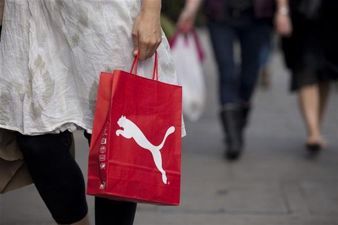 London / Herzogenaurach, Germany – After more than ten years of successful implementation of its social and environmental standards (puma.safe) and the introduction of its company initiative PUMAVision last year, Sportlifestyle company PUMA launched the next pivotal phase of its ambitious long-term sustainability program on Tuesday at the Design Museum in London. By introducing its cutting-edge sustainable packaging and distribution system by renowned industrial designer Yves Béhar, PUMA will set new standards within the Sportlifestyle retail industry. The new innovative solution will significantly reduce the amount of waste and CO2 emissions that traditional product packaging such as shoe-boxes and apparel polyethylene bags generate and underpins PUMA’s target of reducing carbon, energy, water, and waste by 25%, and developing 50% of its international product collections in footwear, apparel and accessories according to best practice sustainability standards by 2015.
London / Herzogenaurach, Germany – After more than ten years of successful implementation of its social and environmental standards (puma.safe) and the introduction of its company initiative PUMAVision last year, Sportlifestyle company PUMA launched the next pivotal phase of its ambitious long-term sustainability program on Tuesday at the Design Museum in London. By introducing its cutting-edge sustainable packaging and distribution system by renowned industrial designer Yves Béhar, PUMA will set new standards within the Sportlifestyle retail industry. The new innovative solution will significantly reduce the amount of waste and CO2 emissions that traditional product packaging such as shoe-boxes and apparel polyethylene bags generate and underpins PUMA’s target of reducing carbon, energy, water, and waste by 25%, and developing 50% of its international product collections in footwear, apparel and accessories according to best practice sustainability standards by 2015.
Home Updates
PUMA’s New Packaging & Distribution System to Save More than 60% of Paper & Water Annually
PUMA has been collecting E-KPIs (Environmental Key Performance Indicators) from all its offices and stores worldwide for the last five years and identified several key areas that need to be dealt with in order to further reduce PUMA’s “paw print”. To address these issues, PUMA is launching its next phase of puma.safe initiatives in the company’s long-term sustainability program laying out ambitious targets to be achieved by 2015. The major objectives PUMA has set out to achieve in this period include:
- 25% reduction of CO2, energy, water and waste in PUMA offices, stores, warehouses and direct supplier factories.
- Paperless office policy through a 75% reduction and offsetting initiatives for the remaining paper usage such as tree planting initiatives.
- 25% CO2 reduction through more efficient product transport solutions by our logistic partners.
- Begin collaborating with our strategic suppliers and logistic service providers to offset their own footprints in the long-term.
- Introduction of the PUMA Sustainability-Index (S-Index) standard that serves as a benchmark for sustainable products and communicates the products’ sustainable features to consumers.
- 50% of PUMA’s international collections will be manufactured according to the PUMA SIndex standard by 2015, using sustainable materials such as organic cotton, Cotton Made in Africa or recycled polyester as well as applying best practice production processes.
To monitor these objectives PUMA is also establishing an external Advisory Board of experts in sustainability to consult on PUMA’s mission and audit PUMA’s sustainability program.
“For a long time our mission has been to become the most desirable Sportlifestyle company. With this next phase of our sustainability program we have evolved our mission to be the most desirable and sustainable Sportlifestyle company in the world,” said Jochen Zeitz, Chairman and CEO of PUMA. “Through PUMAVision and our puma.safe program we have already started to reduce our carbon emissions, curtail wasteful transportation, recycle and reuse available materials, use water sparingly and become paperless.”
Through PUMAVision, our vision of a better world, initiatives fall under the three pillars of puma.safe, puma.peace, and puma.creative to drive the company to cleaner, greener, safer and more sustainable systems and practices contributing to peace as well as promoting creativity and the arts. Under the puma.safe program, PUMA’s ultimate objective is to give back to the environment what it has taken. PUMA’s longstanding work and efforts to improve social, labour and environmental standards throughout its operations date back to 1999. From that time, the company has continuously incorporated environmentally-friendly practices to reduce its impact on the planet and realized several successful large-scale initiatives such as sourcing of raw materials through the Cotton made in Africa campaign to building the capacity of its suppliers as well as the opening of the industry’s first carbon neutral head office – the PUMAVision Headquarters in Herzogenaurach, Germany – last year after joining the UN Climate Neutral Network.
The next milestone in PUMA’s mission to be the most desirable and sustainable Sportlifestyle company in the world is the introduction of an innovative packaging and distribution system for PUMA products that will reduce the paper used for shoeboxes by 65% and carbon emissions by 10 tons per year – the remaining packaging materials used will be fully sustainable by 2015. PUMA partnered with designer Yves Béhar, of San Francisco based fuseproject, to rethink the way the millions of pairs of shoes that it sells each year are packaged – less packaging means fewer raw materials, less use of water and energy to produce, and less weight to ship and to be disposed of. Béhar designed a “Clever Little Bag” to replace the cardboard shoebox with a reusable shoe bag, that protects each pair of shoes from damage from the point it leaves the factory until the consumer takes it home – thus generating savings on the production side due to less material used, reducing weight during transport and eliminating the need for extra plastic carrier bags. As a result of the 65% paper reduction through the “Clever Little Bag” concept PUMA will reduce water, energy and diesel consumption on the manufacturing level by more than 60% per year. In other words: approximately 8,500 tons less paper will be consumed, 20 million Megajoules of electricity saved, 1 million litres less of fuel oil used and 1 million litres of water saved. During transport 500,000 litres of diesel is saved and lastly, due to the replacement of traditional shopping bags with the lighter built-in bag the difference in weight can save up to 275 tons of plastic.
“I was excited to partner with PUMA and contribute to such a game changing project,” said Yves Béhar. “PUMA’s initiative to look closely at one of the most challenging issues facing the retail industry in regards to sustainability and environmental harm was inspirational. In changing the packaging and distribution life cycle from the ground up, we hope our new design and comprehensive solution encourages other retail companies to follow suit.”
PUMA’s apparel collections will be bagged using sustainable material, replacing traditional polyethylene bags. This means that 720 tons of polyethylene bags can be avoided per year, which equals a saving of 29 million plastic bags – enough to cover an area the size of 1000 football pitches. Furthermore, PUMA T-shirts will be folded one more time to reduce the packaging size and thus saving CO2 emissions and costs during transport.
By switching out current plastic and paper shopping bags in PUMA stores and replacing them with sustainable biodegradable bags the sportlifestyle company is looking to save another 192 tons of plastic and 293 tons of paper annually.
The roll out of the new packaging and distribution system is planned as of the second half of 2011.
PUMA’s long-term sustainability program, however, will not stop with the accomplishment of the ambitions outlined above. The company takes responsibility to further reduce harm, working towards closed-loop systems and recycling programs. PUMA will continue to find innovative solutions that no longer deplete resources and will offset its “paw print” where further mitigation is not possible.
PUMA will make its next significant announcement on sustainability in the framework of the United Nations conference “The Business for the Environment Summit (B4E)” in Seoul on 22–23 April 2010.
Notes:
Further information on PUMA’s sustainability concept PUMAVision and current initiatives can be found in PUMA’s sustainability report.
http://ir2.flife.de/data/puma_csr/igb_html/index.php?bericht_id=1000001
Source:PUMA, April 13, 2010







